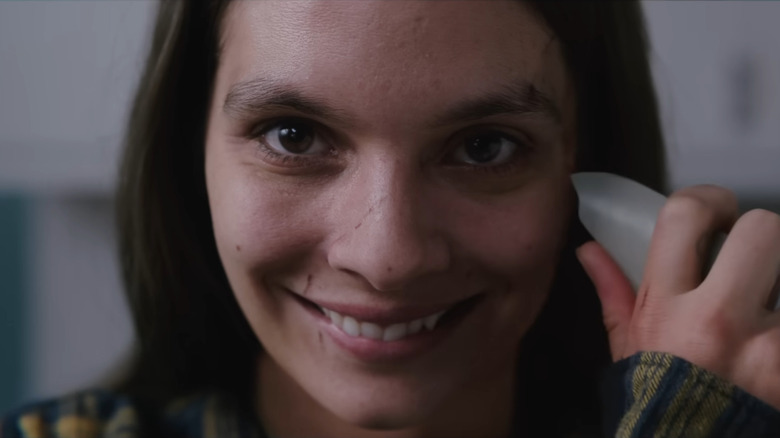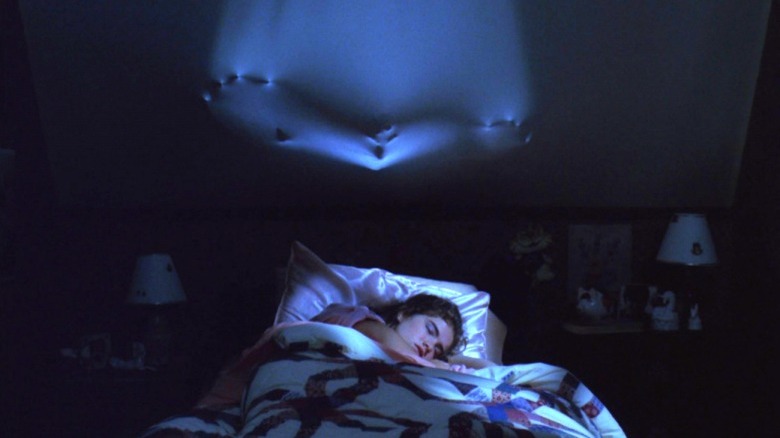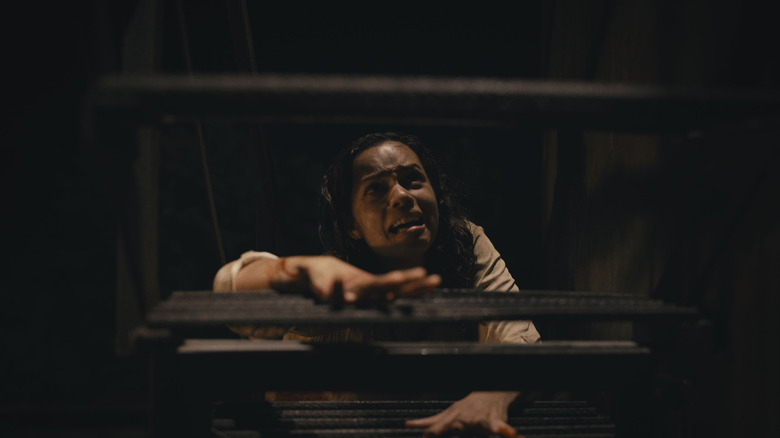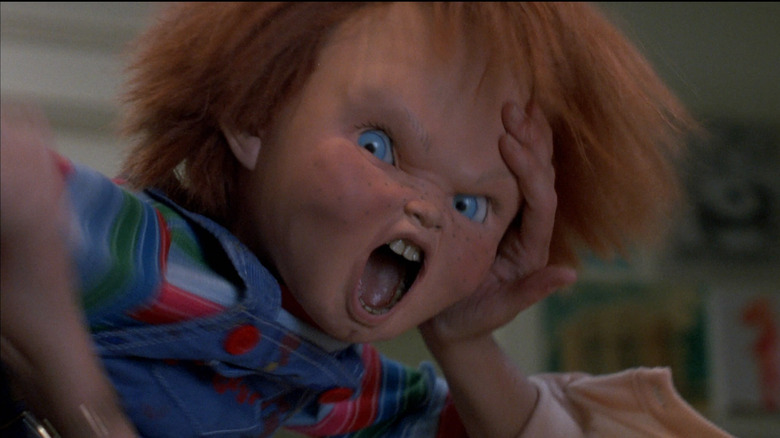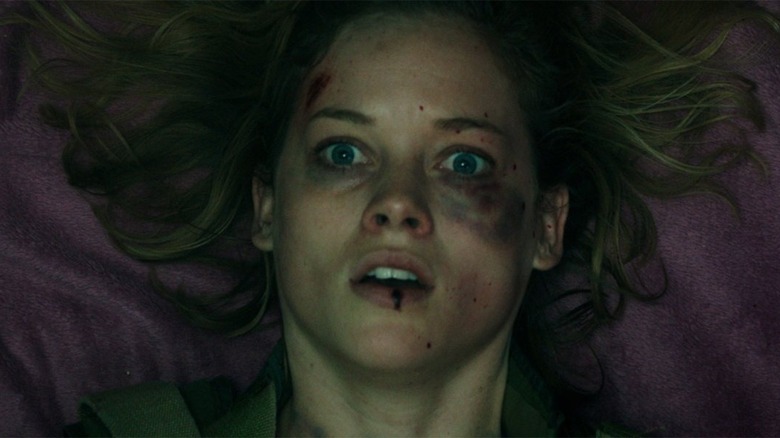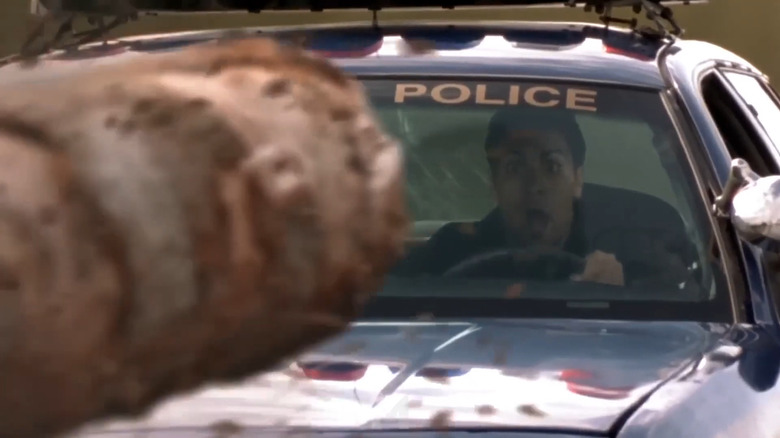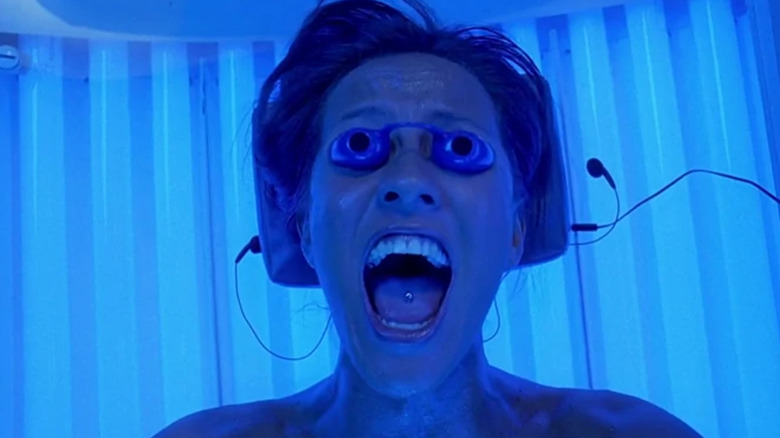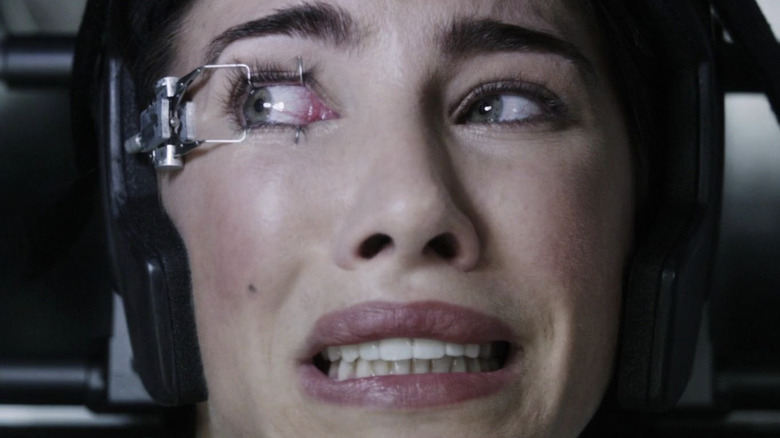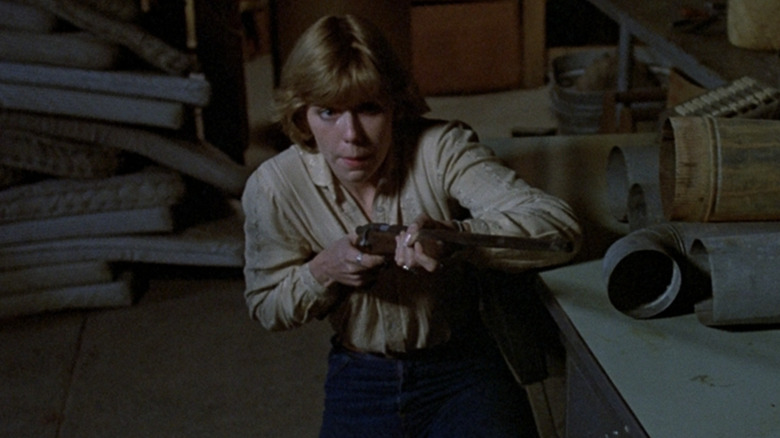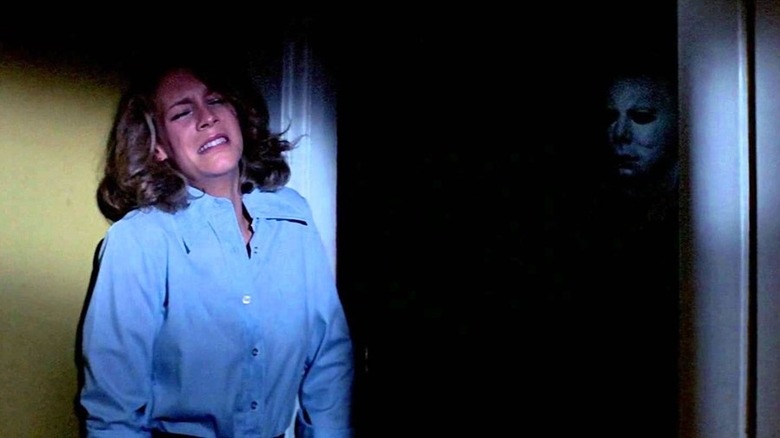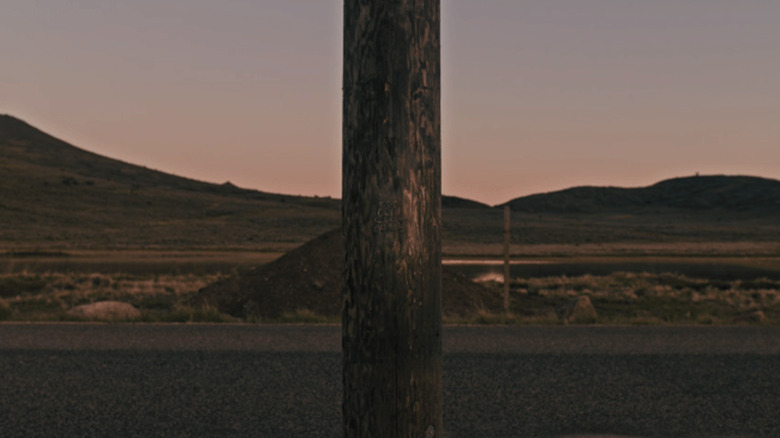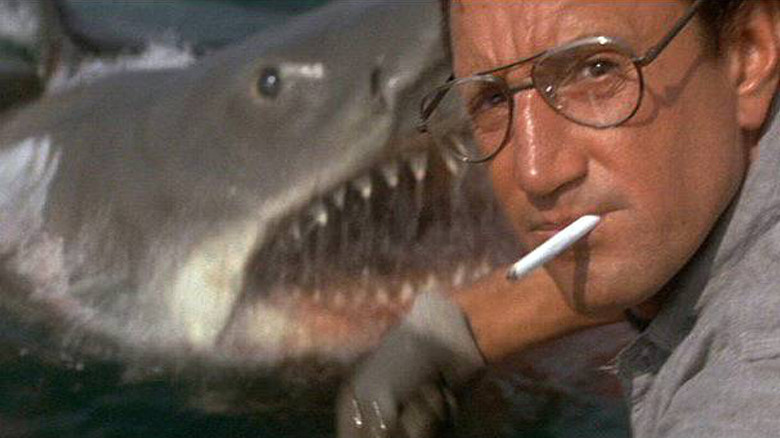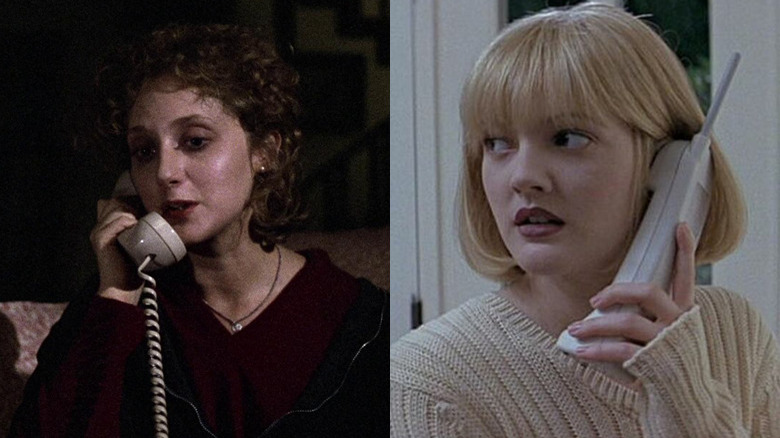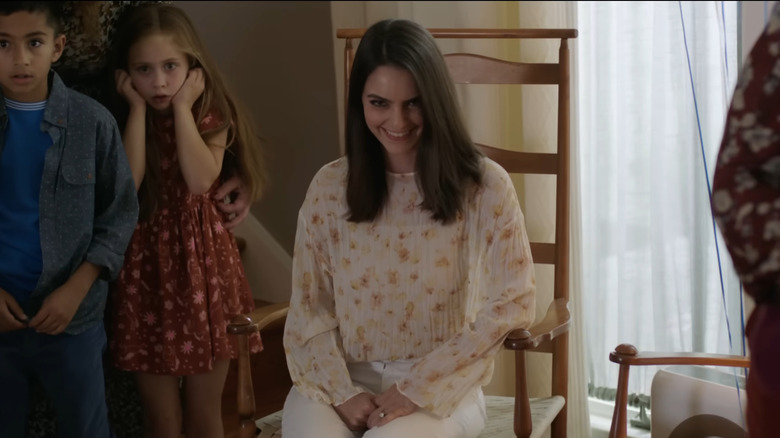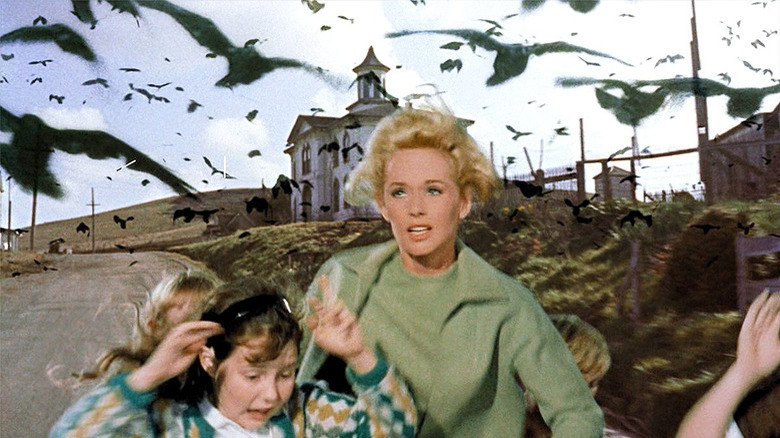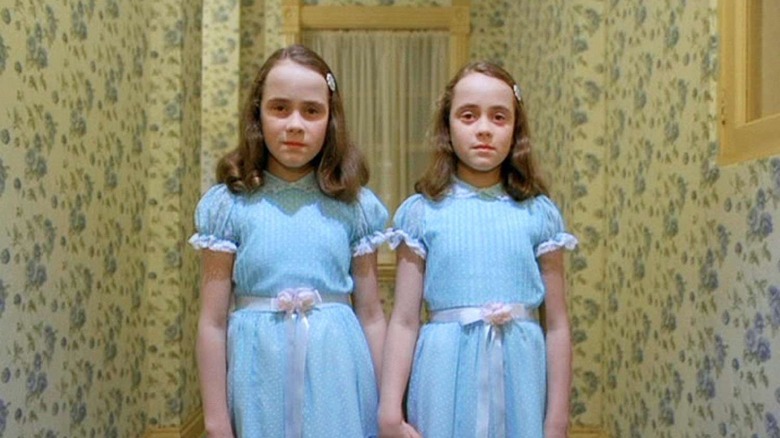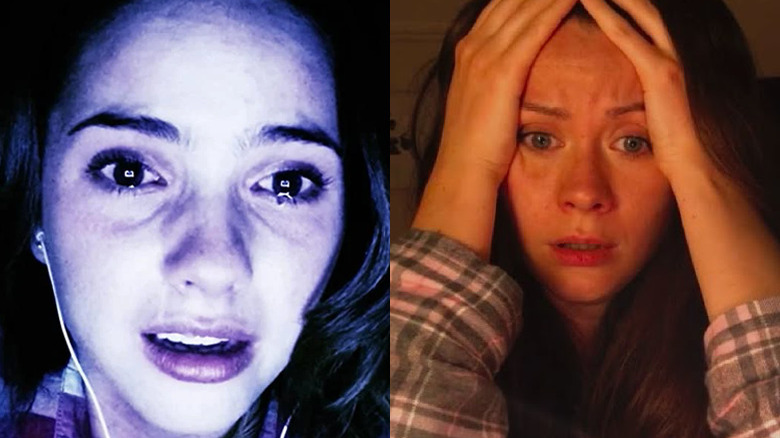Horror Movies That Made Everyday Things Terrifying
Horror is arguably one of cinema's most dependable genres when it comes to both box office and story. In a day and age when theatrical attendance is down and many forgettable or generic films quickly enter obscurity, horror seems to be thriving. In fact, it's one of the few genres that reliably draws people away from their TVs and into the theaters (via Yahoo! Money).
There are many reasons for this, not the least of which is the genre's ability to subsist off of smaller-than-average budgets and generate massive returns (via LAist). However, a major contributing factor is horror's unique ability to enter mainstream conversation by utilizing everyday things most people wouldn't blink twice at.
For example, one of the biggest hits of 2022 was "Smile," a film that makes the act of smiling downright terrifying. But it doesn't stop there, as horror films have been turning seemingly innocent things into death traps for decades now. So, grab some popcorn and shut the lights, as we take you through the horror movies that made everyday things terrifying.
Warning: major spoilers below.
A Nightmare on Elm Street - Going to sleep
Freddy Krueger aka The Springwood Slasher is the original man of your dreams, or rather, your nightmares. The "Nightmare on Elm Street" franchise was the brainchild of one Wes Craven. He based it largely off of a disturbing news article about a young Cambodian refugee, who started having terrible nightmares and stopped sleeping out of fear of being attacked by what was in his dreams (via Vulture).
The film centers around the small town of Springwood, which finds itself menaced by a mysterious assailant. The murderer is soon discovered to be the vengeful spirit of Freddy Krueger, a child predator killed by an angry mob of Springwood parents. However, now Krueger is back and able to stalk their children while they are asleep. If they die in their dreams, they die for real. So, Nancy Thompson, daughter of the local police chief, must use her wits to defeat Krueger and live to sleep another night.
Following its release in 1984, "A Nightmare on Elm Street" quickly became a viable horror commodity that launched one of the most successful horror franchises ever and turned Freddy Krueger into a household name (via Rotten Tomatoes). Throughout the '80s, there were countless kids who likely had a hard time getting to sleep, afraid that Mr. Krueger would be waiting for them. It's understandable since kids already have active imaginations as it is, so adding the idea of a dream stalking killer to the mix is quite the double whammy.
Barbarian - Airbnbs
Zach Cregger's "Barbarian" is a movie whose marketing campaign could best be described as minimalist. What little the trailers showed us was scant and intentionally vague, aside from seeing the principal players and getting a vague sense of the setting.
A young woman named Tess arrives at her rented Airbnb on a dark and rainy night in a Detroit suburb. However, when she gets to the door, she finds the house is already inhabited by Keith, a seemingly friendly guy, who also rented the space. It's already an uncomfortable and potentially terrifying setup, but "Barbarian" then tears the rug out from the audience ... over and over again. Soon enough Tess discovers a hidden passageway, as well as a sinister room with a camcorder, and that's not even the half of it.
While renting Airbnbs has become as commonplace as getting a hotel room, doing so is already a bit of a gamble, since you can never be too careful with unfamiliar settings, particularly those rented out by strangers. "Barbarian" takes the potential danger of not knowing what you're getting into with an Airbnb to an impressively gonzo degree, ensuring that future users will vet their next location very carefully.
Child's Play - Dolls and toys
If you were a kid who turned your toys' faces away from you at night, there's a good chance it was Chucky's fault. Don Mancini's 1988 film about a Good Guy doll possessed by the spirit of a dead mass murderer definitely changed the way we look at our toys.
Six-year-old Andy Barclay wants nothing more for his birthday than a Good Guy, which his mother acquires from a scummy peddler. Unfortunately, this doll was found outside a toy store the same night Charles Lee Ray, the Lakeshore Strangler, was gunned down by Detective Mike Norris. Now, Charles aka Chucky has the perfect cover to continue his murder spree — as a seemingly innocent doll from a Saturday morning cartoon.
The first "Child's Play" was such a smash hit that it spawned six sequels, a television series, and merchandise and perhaps that success is because it's rendered somewhat in reality. Mancini told USA Today that he was inspired by the "creepily popular" Cabbage Patch Kid dolls in the '80s and initially set out to make a film about the nefarious role of marketing in society.
Clearly, he hit a nerve, since nowadays you can't have an evil doll or puppet in a movie without making people think about Chucky. With the character still as popular as ever, it's only a matter of time before a brand new generation is made scared of their toys all over again.
Don't Breathe - Turkey basters
"Don't Breathe" has a simple yet suspenseful setup: A trio of burglars plans to rob a blind war veteran's house under the cover of night. The man, Norman, received a hefty financial settlement after someone accidentally killed his daughter in a hit and run. However, Norman soon reveals himself to be a killing machine despite his visual disability, as he easily kills one of them in mere moments. Now, the remaining burglars, Rocky and Alex, must find the money and escape the house before they are discovered as well.
Home invasion movies aren't anything new, as they've been seen before in countless films such as "The Strangers" and "Wait Until Dark." But in the second act, "Don't Breathe" completely rear ends the audience's expectations of the genre by revealing its disturbing twist: Norman has been keeping the woman who ran over his daughter chained up in his basement. Not only that, but he's also non-consensually artificially inseminated her so that she can replace his daughter with another child.
After the woman accidentally gets killed, Norman tries to use Rocky as a substitute. He straps her into place and prepares a turkey baster full of his DNA. It's grotesque and stomach-churning on multiple levels, particularly as the camera goes into sickening closeups of his preparation. It is a moment of true horror that viewers are likely to never forget. If you've seen the movie, perhaps you've stopped seeing turkey basters as a delicious tool and now just see them as a disgusting one.
Final Destination 2 - Driving behind log trucks
Realistically, we could have populated this entire list with just entries from the "Final Destination" films, which contain some of horror's most creative death scenes. Every film in the series follows a group of people, who cheat death thanks to the protagonist's premonition. However, they're not exactly off the hook, as they all wind up dying in some horrific incident to restore the balance of life and death.
This includes everything from airplane crashes to roller coasters derailing to a racetrack explosion. But for many viewers, it's a massive death caused by a logging truck in 2003's "Final Destination 2" that made them think twice about getting behind a wood-filled truck on the highway.
In the scene, a truck's load of logs accidentally fly off onto the road into the cars behind it, which causes multiple graphic deaths. What makes this moment so terrifying is that many of us have driven past one of those trucks and those of us who have seen "Final Destination 2" have done so with ample caution (and then some).
"Final Destination 2" is far from a horror masterpiece; however, it's impressive just how many people still remember this scene decades later. If you go hunting online, you're likely to find a swath of different memes referring to this infamous onscreen vehicular incident. Ultimately, what could've been just another disposable horror sequel from the 2000s has instead attained a permanent place in many people's minds.
Final Destination 3 - Tanning beds
While far from the series' strongest entry, 2006's "Final Destination 3" is still loaded with a bounty of memorable death scenes. Partway through the movie, Ashley and Ashlyn, two of the survivors of a roller coaster crash, go to a tanning salon. It's an innocent setup for sure, until the owner of the salon is called away momentarily and gets locked out of the building.
This allows Death — now stalking his unclaimed victims — to slink in and quite literally cook up their demise. As the two girls lay down for their bronzing, Death messes with temperature on the tanning beds. Not only that, but Death even manages to Rube Goldberg a surfboard over the two beds and trap the girls inside. With the temperature rising and the owner locked out, the girls are left to roast alive in the tanning beds in one of the series' most unforgettable moments.
This culminates in a morbid yet hysterical moment where we immediately cut from the dual tanning beds to a pair of dual coffins. Sure, using tanning beds is already fairly inadvisable from a health perspective, but this scene has definitely made people a bit warier of it.
Final Destination 5 - Lasik eye surgery
"Final Destination 5" often gets overlooked by people, despite the fact it has a couple of the series' coolest and more disturbing moments. From a bridge collapsing to a gymnastics routine gone wrong to a bloody spa day, the film has plenty of memorable deaths. However, none is more memorable than that fate that befalls Olivia when she goes in for her routine lasik eye surgery.
For those not in the know, lasik eye surgery is a process wherein a laser is used to treat nearsightedness, farsightedness, and astigmatism. In the scene, Olivia is laid down with Surgical Eye Specula, which holds her eyes open as the laser begins its work.
However, it seems Death also has an appointment that day as well, and he shorts out the machine performing the procedure. This causes the laser to begin horrifically burning Olivia's eyes. She's able to escape but she's so visually impaired that she stumbles backwards and falls out the window to her demise.
While far from realistic, it's a scene that'll definitely make anyone rethink their upcoming lasik eye surgery.
Friday the 13th (Camping)
The "Friday the 13th" series will always be best known for two things: creating a slasher icon in Jason Voorhees and making summer camps a horror movie hotspot. Released in 1980, the original "Friday the 13th" follows a group of camp counselors, who are preparing a previously closed summer camp to reopen for a new season. They're enjoying themselves, singing songs by the campfire, and sleeping with each other, but their fun is soon cut short by an unknown killer brandishing a very sharp machete.
While nowadays, the idea of a killer in the woods stalking kids and counselors at a summer camp is a widespread and celebrated horror cliché, it all began with "Friday the 13th," which established these tropes and others like promiscuous camp counselors.
It's not hard to see why this premise was so successful, as summertime camping is a beloved and for many, calming and wholesome activity. So, the idea of that serenity being disrupted by a hockey mask-wearing maniac with a machete is an unnerving idea to be sure. It also doesn't help that the peacefulness of camping is already somewhat precarious since the woods are an isolating and unpredictable environment with or without a serial killer lumbering through them.
If you ever go camping or to summer camp, there's a good chance a prank involving a hockey mask is in your future. These days, it's nearly impossible to take a summer time camping trip without imagining Mr. (or Mrs.) Voorhees waiting in the woods to claim his next victim.
Halloween - Babysitting
The original "Halloween," directed by John Carpenter and released in 1978, is the film most responsible for kicking off the slasher boom of the late-'70s and the early-'80s. The film's premise is as simple as it gets: A psychopath named Michael Myers escapes from the asylum 15 years after he murdered his own sister. Now, on Halloween night in 1978, a local babysitter named Laurie Strode finds herself in Myers' crosshairs.
The brilliance of "Halloween" comes from how barebones it is, as well as how familiar its setting is for viewers. Many people have either lived in or at least stopped by a small town like Haddonfield at some point. Additionally, the idea of a babysitter is a concept we're all familiar with, whether as an idea or actual practice to make some cash in our youth.
It's this level of familiarity that makes the film so effective, which hinges upon the idea that even in Small Town, USA, you aren't safe from evil. We have no doubt that anyone who's seen the original "Halloween" and then taken a babysitting job has nervously peeked through the blinds once (or 100 times). And we don't blame them.
Hereditary - Telephone poles
When the marketing for Ari Aster's "Hereditary" began making the rounds, nobody knew exactly what to expect from it. The trailers, while effectively disturbing, only gave the vaguest sense of just what the movie was about.
"Hereditary" centers around the Grahams — Annie, Steve, Peter and Charlie — a family with a significant amount of baggage. We first meet them at the funeral for Annie's mother, Ellen, who was an emotionally distant and controlling person. Not long after the funeral, Annie's teenage son Peter attends a party and is forced to take his younger sister Charlie with him. Partway through the party, Charlie has an allergic reaction to peanuts and Peter is forced to drive like a maniac to get her home. Unfortunately, just as Charlie sticks her head out of the car to get some air, Peter swerves by a telephone pole.
In a flash, Charlie is decapitated and Peter, as well as the audience, is left in stunned silence for what feels like an eternity. In a film rife with horrific moments, this is the one that sticks with audiences the most and it's not hard to see why. For many horror fans, formerly mundane telephone poles have now become an uncomfortable reminder of one of modern horror's most shocking moments.
Jaws - Swimming at the beach
Who doesn't love a day out at the beach during the summertime when the sun is out and all is well? That seemingly simple question took on a whole new meaning thanks to Steven Spielberg and his 1975 smash hit "Jaws."
For the seaside town of Amity Island, what should've been an idyllic summer soon turns into a nightmare when a great white shark begins devouring beachgoers like it's at a Las Vegas buffet. Now, local sheriff police chief Martin Brody must team up with oceanographer Matt Hooper, and fisherman Sam Quint to hunt down the man-eating menace.
"Jaws" was the first true summer blockbuster (via CBR). The film's impact was so significant that not only were people running to the theaters, but it's even been rumored that people ran away from the beach. Considering sharks are an actual creature in the real world, it makes sense that folks might feel a bit skittish to get in the water after seeing Spielberg's classic.
Scientists have described this as "the Jaws effect," as the film has made generations of viewers irrationally terrified of sharks in a way that isn't innate to humans or even based in reality, where there's no such thing as a man-eating shark (via CBS). For better or for worse, Spielberg got the job done, since when it comes to making people fear everyday things, few films have done it better and in grander fashion than "Jaws."
Psycho - Showering
In terms of milking legitimate dread and suspense from everyday things, Alfred Hitchcock remains the unparalleled master of the craft. "Psycho" is a film that truly pioneered the notion of subverting an audience's expectations, especially when it comes to horror cinema.
The film follows Marion Crane, who runs off with $40,000 entrusted to her by her boss. Her escapade leads her to the Bates Motel, where she encounters the motel's eccentric owner Norman Bates. After an awkward dinner with Norman, Marion retires to her room for a shower.
At the time of the film's release, Janet Leigh was not only the prominent star of the film, but she was its supposed protagonist too, so nobody expected what was about to happen. As Marion enjoys her rinse, a killer silently enters the bathroom and stabs her to death.
The bathroom is where people tend to feel the most vulnerable, so the idea of someone exploiting that space is downright terrifying. As cliché as it might sound, there's a reason that anyone who's seen "Psycho" has perhaps a mild to severe fear of showering in an empty house.
Scream and When a Stranger Calls - Phone calls
We've opted to put these two together, as they both played a big part in making something as simple as a phone call terrifying. Nowadays, texting and chatting via social media apps have replaced phone calls as the de facto form of communication. One of the appeals of this transition is removing the guessing aspect of receiving a message from a person you're unfamiliar with.
An early example of a film using phone calls for horrific effect was in Fred Walton's "When a Stranger Calls" from 1979. The first 20 minutes are probably best known for the famous line, "The calls are coming from inside the house."
This idea of a stalker calling you while watching you nearby was later expanded upon in Wes Craven's "Scream" from 1996. "Scream" took things a step further with a clever subversion that's similar to Alfred Hitchcock's "Psycho."
"Scream" begins with Drew Barrymore — at the peak of her popularity — answering a call from a stranger, who wants to play a movie trivia game. It's all fun and games until she realizes that the call is coming from inside the house and this mega star gets gruesomely axed in one of the most terrifying opening scenes ever.
Both of these films helped to solidify the anonymous caller as an effective horror trope for many years to come. Given the distressing realism of stalker phone calls, all we can say is, thank goodness for caller ID and texting.
Smile - Smiling
From the moment the first trailer dropped, people could tell that "Smile" was going to be a unique movie. Not that creepy smiles hadn't been seen in horror movies before, but never to the point of making them a film's focal point.
Dr. Rose Cotter is a psychiatrist who witnesses one of her patients flash a demented grin before slitting her own throat. Now, it seems as though a curse of some sort has been put on Rose, who now begins seeing smiling people everywhere she goes. Additionally, seeing how Rose is the only one who can see these smiling people, everyone around her writes her off as unhinged.
It makes for a supremely unnerving viewing experience, making the film's box office success not surprising in the least. Helping matters was the film's brilliant marketing campaign, which enlisted creepy smilers to pop up in spaces like baseball games and "The Today Show" (via High Snobiety).
Whether you loved it or not, there's no denying that the image of someone smiling with a massive grin has now become unsettling for many people thanks to "Smile."
The Birds - Birds
Leave it to Hitchcock to not only make the simple act of showering scary, but to do the same to birds as well. "The Birds" is one of Hitchcock's more flamboyant movies, aided majorly by its absurd yet disturbing presence. Melanie Daniels brings two lovebirds to Bodega Bay as a surprise gift for the sister of Mitch Brenner, a man she's interested in. However, shortly after her arrival, the area begins to see an influx of bizarre and violent behavior from the local birds. This includes a man getting his eyes pecked out and a school playground being swarmed with an army of the flying assailants.
In fairness, there are some birds who fall in the deadly predator category, but certainly not every single species. This film successfully takes an animal many of us find innocuous and turns it into the equivalent of a zombie outbreak. To this day, whenever anyone sees birds swarming a local playground, they'll likely be thinking about "The Birds."
The Shining - Twin children
Stanley Kubrick's cinematic adaptation of Stephen King's novel "The Shining" is a complex film, both in terms of its themes and its cinematography. While a definite departure from its literary counterpart, the film succeeds at engrossing the audience in a perpetual feeling of unease and delirium.
Jack Torrance, his wife Wendy, and son Danny venture to the remote Overlook Hotel, where Jack is serving as the winter caretaker during the offseason. While there, Jack attempts to get some writing done while staving off cabin fever. However, before too long, the Overlook begins to prey upon the family, going as far as to haunt them with the ghosts of its past.
While each character has their own terrifying encounters with phantoms and each other, for many, the scariest is Danny's meeting two twin girls in matching dresses, as he rides his tricycle through the hotel's hallways. The two girls simply stand shoulder to shoulder and ask Danny to come play with them forever and forever, which is haunting stuff for the ages.
Children already have a pretty creepy track record in horror as it is, but these two definitely took the game to another level. Nowadays, any set of twin girls, even if they are the friendliest people in the world, will likely be compared to the twins from "The Shining."
Unfriended and Host - Online video chats
"Unfriended" and "Host" both take a look at the age of digital communication via the lens of horror. In many ways, the internet has always been portrayed as dangerous, as seen in 1995's cyber thriller "The Net" starring Sandra Bullock. However, given the ever-evolving nature of the internet and technology, films have needed to keep up with the changing trends and horror has been one of the most fruitful and interesting genres to do so.
In "Unfriended," we meet Blair and her group of friends who are on a Skype chat and find themselves menaced by a mysterious user. Soon enough, they determine that this user — known as Billie — might be the ghost of Laura — a former friend of theirs, who died by taking their own life. Now, Laura begins turning the friends against each other, all while butchering them one-by-one.
In "Host," we are thrust into a 40-minute Zoom call, wherein an international group of friends chat during the COVID-19 lockdown. To pass the time, the group partakes in a socially distanced seance, which is where things go sideways. In mere moments, each participant soon finds themselves haunted and menaced by an unseen supernatural entity.
Both films use the online video chat format in interesting ways, even using computer glitches as a visual motif, and while many people might have thought that Zoom happy hours were the scariest thing to come out of this technology, both "Unfriended" and "Host" have shown the actual terrifying potential of video chats.
If you or anyone you know is having suicidal thoughts, please call the NSP Lifeline by dialing 988 or by calling 1-800-273-TALK (8255).
